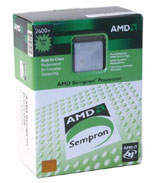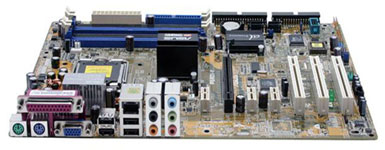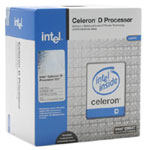Entry Level Buyer's Guide, October 2005
by Jarred Walton on October 14, 2005 12:05 AM EST- Posted in
- Guides
Office CPU and Motherboard Recommendations
We've wavered back and forth between choosing integrated graphics vs. discrete graphics for the budget systems. Outside of gaming, though, there isn't really a need for even a low-end graphics card. The woefully inadequate - at least for games - Intel Extreme Graphics 2 in the 865G chipset is still perfectly good for office work. Newer options like the 915G's GMA900 and the 945G's GMA950 are quite a bit faster than the 865G, but they're still slower than almost any add-in card. We also have IGP options from both NVIDIA and ATI now, rounding out the possibilities.
What about Windows Vista, right? If Vista ships and you find that your IGP can't meet the demands, the solution is simple: buy a graphics card at that point in time. The $50 budget cards of late 2006 will be far more powerful than the $50 cards that are currently available. The only thing that you need to do is to make sure that your motherboard has an add-in graphics port, preferably PCIe X16. Our recommendations will meet that requirement. We'll start with the AMD choices.
AMD Office Motherboard: Biostar GeForce 6100-M7
Price: $66 shipped
AMD Office CPU: Sempron 64 (754) 2600+ - 128KB, 1.60 GHz Palermo
Price: $63 shipped (Retail)
Total: $129
We covered the launch of the NVIDIA 6100 chipset recently, and we've even done a follow-up with some BIOS updates for the ATI board. The end result is that performance is relatively close between the two contenders, so the purchase decision really depends on price. Biostar makes the only currently shipping 6100 board, while there are a few shipping Xpress 200 boards. However, only one socket 754 Xpress 200 board is available, and since we'd just as soon not spend an extra $50 on the processor, our choice is narrowed to the MSI RS480M-IL 754 or the Biostar GeForce 6100-M7. $91 vs. $65 makes the decision a no-brainer.
Athlon 64 for socket 754 represents a much faster solution, but it carries a higher cost as well. We took a look at all the shipping socket 754 processors that include 64-bit support - why get a regular Sempron when the 64-bit enabled versions typically cost less than a dollar more, right? The Sempron 2500+ starts at $63, as does the 2600+. Do you want 1.40 GHz with 256K of cache or 1.60 GHz with 128K of cache? Or do you spend the extra $11 to get both with the Sempron 2800+? Perhaps another $10 to drop back to 128K cache, but increase the CPU speed to 1.80 GHz, courtesy of the 3000+, would be best? Beyond the 3000+, prices jump $20 for the 3100+. OEM versions are $10 cheaper, but since a heat sink and fan will cost that much, there's little reason to pick up such a chip. (OEM chips from AMD are going to disappear soon, if that concerns you.) If your budget is really tight, though, the Sempron 2600+ packs the most bang for the buck.
We're going to downgrade performance as well as lower the price relative to the last Budget Guide, and save the slightly faster picks for the gaming configurations. Compared to our mid-range picks from last month, you're getting the CPU as well as the motherboard for less than the cost of just the CPU. Sure, it's a slower system overall, but it's still plenty fast for most computer needs. If you're doing something that requires more processing power, we're doubtful that you'd even consider a budget system.
If you really want a faster CPU, Athlon 64 chips are a good buy, but we'd suggest moving to socket 939 if you can manage to spend the extra money. Overclockers looking for bang-for-the-buck could try out the Turion chips, but at current prices, you would be far better off with socket 939 and Venice cores. Sempron Palermo parts like the 3000+ and 3100+ work pretty well at speeds up to 2.5 GHz, but the reduced cache of the 3100+ will just about equal a 2.2 GHz 512K Athlon 64. For overclocking on the cheap, you can save around $100 relative to a non-overclocked 939 system. (Did we just use "cheap" and "overclocking" in the same sentence? Yeah, it's probably asking for too much - move along, nothing to see here...)
Intel Office Motherboard: ASUS P5RD1-V
Price: $91 shipped
Intel Office CPU: Celeron D 331 - 256KB, 2.66 GHz Prescott
Price: $79 shipped (Retail)
Total: $170
Intel platform motherboards are almost always more expensive, and that's the case here. There is as yet no NVIDIA competitor for socket 775, so our IGP choices are limited to ATI's Xpress 200 or Intel's 915G and 945G. The 915G and Xpress 200 both lack support for Pentium D chips, but the likelihood of upgrading to such a processor during the life of the computer is small. 945G costs about $10 more than 915G - you'll want to avoid the GL and GV versions of the chipsets if you want dual-channel RAM support. Since 915G is at EOL (End of Life), we narrowed the final choice down to the 945G and Xpress 200, and opted to go with the latter for the improved IGP. If you really don't care about graphics performance at all, the 945G has slightly better overall performance. In either case, you can always add a faster discrete card in the future.
There are at present two Xpress 200 socket 775 boards on the market. One is from ECS and the other is from ASUS, and while the ECS board is $20 cheaper, it also comes with two DDR and two DDR2 slots. DDR2 is no more expensive than DDR these days, but since you can't use both in the ECS board, you end up with two usable DIMM slots. Even for a budget system, we would much rather have the potential to add more RAM, so we went for the ASUS with its four DDR slots. The word on the street is that, unlike the early AMD Xpress 200 boards, the ASUS board for socket 775 can actually overclock decently. Most budget shoppers probably won't care one way or the other, of course.
The CPU prices on Intel bottom out around $75, where AMD CPUs can go for as little as $60. We looked at all the Intel processors and found that the best choice was the Celeron D 331. The 331 is a newer version of the 330 chip with enabled EM64T support. Budget computing and 64-bit power seems a bit of a mismatch right now, but if you plan on keeping the computer for three or four years, 64-bit support might become important. Performance, as with the Sempron selection, should be adequate for most business and home user tasks. Even light gaming will work well, provided the IGP is sufficient - integrated graphics will be the bottleneck for just about any game anyway.
We've wavered back and forth between choosing integrated graphics vs. discrete graphics for the budget systems. Outside of gaming, though, there isn't really a need for even a low-end graphics card. The woefully inadequate - at least for games - Intel Extreme Graphics 2 in the 865G chipset is still perfectly good for office work. Newer options like the 915G's GMA900 and the 945G's GMA950 are quite a bit faster than the 865G, but they're still slower than almost any add-in card. We also have IGP options from both NVIDIA and ATI now, rounding out the possibilities.
What about Windows Vista, right? If Vista ships and you find that your IGP can't meet the demands, the solution is simple: buy a graphics card at that point in time. The $50 budget cards of late 2006 will be far more powerful than the $50 cards that are currently available. The only thing that you need to do is to make sure that your motherboard has an add-in graphics port, preferably PCIe X16. Our recommendations will meet that requirement. We'll start with the AMD choices.
 |
 |
| Click images to enlarge. | |
AMD Office Motherboard: Biostar GeForce 6100-M7
Price: $66 shipped
AMD Office CPU: Sempron 64 (754) 2600+ - 128KB, 1.60 GHz Palermo
Price: $63 shipped (Retail)
Total: $129
We covered the launch of the NVIDIA 6100 chipset recently, and we've even done a follow-up with some BIOS updates for the ATI board. The end result is that performance is relatively close between the two contenders, so the purchase decision really depends on price. Biostar makes the only currently shipping 6100 board, while there are a few shipping Xpress 200 boards. However, only one socket 754 Xpress 200 board is available, and since we'd just as soon not spend an extra $50 on the processor, our choice is narrowed to the MSI RS480M-IL 754 or the Biostar GeForce 6100-M7. $91 vs. $65 makes the decision a no-brainer.
Athlon 64 for socket 754 represents a much faster solution, but it carries a higher cost as well. We took a look at all the shipping socket 754 processors that include 64-bit support - why get a regular Sempron when the 64-bit enabled versions typically cost less than a dollar more, right? The Sempron 2500+ starts at $63, as does the 2600+. Do you want 1.40 GHz with 256K of cache or 1.60 GHz with 128K of cache? Or do you spend the extra $11 to get both with the Sempron 2800+? Perhaps another $10 to drop back to 128K cache, but increase the CPU speed to 1.80 GHz, courtesy of the 3000+, would be best? Beyond the 3000+, prices jump $20 for the 3100+. OEM versions are $10 cheaper, but since a heat sink and fan will cost that much, there's little reason to pick up such a chip. (OEM chips from AMD are going to disappear soon, if that concerns you.) If your budget is really tight, though, the Sempron 2600+ packs the most bang for the buck.
We're going to downgrade performance as well as lower the price relative to the last Budget Guide, and save the slightly faster picks for the gaming configurations. Compared to our mid-range picks from last month, you're getting the CPU as well as the motherboard for less than the cost of just the CPU. Sure, it's a slower system overall, but it's still plenty fast for most computer needs. If you're doing something that requires more processing power, we're doubtful that you'd even consider a budget system.
If you really want a faster CPU, Athlon 64 chips are a good buy, but we'd suggest moving to socket 939 if you can manage to spend the extra money. Overclockers looking for bang-for-the-buck could try out the Turion chips, but at current prices, you would be far better off with socket 939 and Venice cores. Sempron Palermo parts like the 3000+ and 3100+ work pretty well at speeds up to 2.5 GHz, but the reduced cache of the 3100+ will just about equal a 2.2 GHz 512K Athlon 64. For overclocking on the cheap, you can save around $100 relative to a non-overclocked 939 system. (Did we just use "cheap" and "overclocking" in the same sentence? Yeah, it's probably asking for too much - move along, nothing to see here...)
 |
 |
| Click images to enlarge. | |
Intel Office Motherboard: ASUS P5RD1-V
Price: $91 shipped
Intel Office CPU: Celeron D 331 - 256KB, 2.66 GHz Prescott
Price: $79 shipped (Retail)
Total: $170
Intel platform motherboards are almost always more expensive, and that's the case here. There is as yet no NVIDIA competitor for socket 775, so our IGP choices are limited to ATI's Xpress 200 or Intel's 915G and 945G. The 915G and Xpress 200 both lack support for Pentium D chips, but the likelihood of upgrading to such a processor during the life of the computer is small. 945G costs about $10 more than 915G - you'll want to avoid the GL and GV versions of the chipsets if you want dual-channel RAM support. Since 915G is at EOL (End of Life), we narrowed the final choice down to the 945G and Xpress 200, and opted to go with the latter for the improved IGP. If you really don't care about graphics performance at all, the 945G has slightly better overall performance. In either case, you can always add a faster discrete card in the future.
There are at present two Xpress 200 socket 775 boards on the market. One is from ECS and the other is from ASUS, and while the ECS board is $20 cheaper, it also comes with two DDR and two DDR2 slots. DDR2 is no more expensive than DDR these days, but since you can't use both in the ECS board, you end up with two usable DIMM slots. Even for a budget system, we would much rather have the potential to add more RAM, so we went for the ASUS with its four DDR slots. The word on the street is that, unlike the early AMD Xpress 200 boards, the ASUS board for socket 775 can actually overclock decently. Most budget shoppers probably won't care one way or the other, of course.
The CPU prices on Intel bottom out around $75, where AMD CPUs can go for as little as $60. We looked at all the Intel processors and found that the best choice was the Celeron D 331. The 331 is a newer version of the 330 chip with enabled EM64T support. Budget computing and 64-bit power seems a bit of a mismatch right now, but if you plan on keeping the computer for three or four years, 64-bit support might become important. Performance, as with the Sempron selection, should be adequate for most business and home user tasks. Even light gaming will work well, provided the IGP is sufficient - integrated graphics will be the bottleneck for just about any game anyway.










35 Comments
View All Comments
grimdeath - Friday, October 14, 2005 - link
good choice on the samsung 997df monitor, i bought mine for the same price at best buy as well around 2 years ago. its still crips, clean and bright :) im not sure how i hear more ppl voting for other brands after looking at this compared to others(though NEC seems decent)JarredWalton - Friday, October 14, 2005 - link
I also own an NEC FE991SB that I purchased for $260 or so 18 months back - maybe even two years ago? Overall, I prefer it to the Samsung, but the Samsung has a higher resolution. Both of them cost more now than they did a year ago, though, which pretty much sucks. Sadly, the new NEC CRT models aren't even equal to the old Samsung monitors.IntelUser2000 - Friday, October 14, 2005 - link
An entry level gaming graphics card is Geforce 6600GT?? Sheesh. My friends who are "Hardcore Gamers" have Radeon 9800 Pro/XT.JarredWalton - Friday, October 14, 2005 - link
I look at "Entry Level" gaming in terms of price, not performance. To me, that means $100 to $150 is ideal, and the 6600GT fits that requirement quite nicely. You can play many games on a slower graphics card, but usually with lower detail settings. Why not spend the extra $30 and get a decent performance boost?You can also think about it another way: how much does a current game cosole cost? $150 or so, right? Take a budget PC - because many people will want a PC in the home for other uses - and you can suddenly have a respectably gaming PC for the same amount as a console. The good news is that a 6600GT will play every game currently available at 1024x768 resolution without difficulty. Many games will even handle 1280x1024 or 1024x768+4xAA.
DrZoidberg - Friday, October 14, 2005 - link
I agree, if u play games regularly the minimum card a gamer should get now would be a 6600gt or 9800pro. A 6600gt is only slightly faster than 9800pro so they both similar cards. Most brand new 9800pro (not crappy se edition) on newegg is selling around $120, so its not much cheaper.